When it comes to drying/curing methods in industrial processes, two popular methods are thermal curing and UV curing . Both of these methods are used to convert liquid or semi-liquid materials into solid form by applying heat or UV radiation. Therefore, we will discuss the difference between thermal drying and UV curing and look into their differences.
While both methods have the same goal of solidifying a substance, there are some significant differences between them.
Heat curing
Is a process that involves applying heat to an ink or coating on a substrate to accelerate its hardening time . Heat drying is commonly used for substances such as epoxies, powder coatings, and certain types of adhesives .
Heat is usually provided by large gas fired hot ovens, forced hot air dryers or infrared lamps, and the temperature and duration of the hardening process depend on the specific substance being cured. These drying lines can be very long, depending on the target production speed and drying time requirements of the ink or coating.
Thermal curing can be used for a wide variety of coatings, including epoxy, polyester, acrylic and polyurethane coatings . These coatings can be applied to a variety of substrates such as metals, plastics and composites.
Some coatings may require special formulations to ensure proper drying during the thermal drying process. For example, some coatings may require the addition of driers or accelerators to increase drying efficiency or reduce drying time.
UV Curing
UV curing, also known as ultraviolet curing , is a process that uses ultraviolet light to cure substances onto substrates. UV curable resins are specifically formulated with photoinitiators that react with the UV light and initiate the polymerization process. The process involves exposing the material to UV light, which triggers a photochemical reaction that causes the monomers and oligomers in the resin to crosslink and form a strong, durable polymer. This means that only resins that contain these photoinitiators can be cured using UV light.
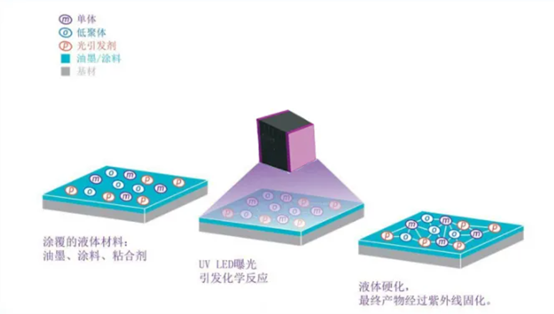
To ensure proper curing, resin manufacturers typically specify the appropriate amount of UV energy in a specific wavelength range as well as the desired UV peak irradiance, which can be affected by the output capabilities of the UV system and its distance from the UV light source and the surface being cured.
In addition to general daily inspections, mechanical or chemical testing may be helpful to confirm that the resin has fully cured. For example, a hardness test can be performed using a durometer to measure the surface hardness of the cured resin. Chemical testing can be done by exposing the surface to solvents or chemicals that the cured resin should withstand to ensure that it does not soften or dissolve, or simply rub off.
In terms of energy consumption and production efficiency, UV curing technology shows obvious advantages over thermal drying technology. This difference mainly stems from the different working principles and energy conversion efficiency of the two technologies.
The energy consumption of UV curing technology is significantly lower than that of thermal curing technology.
Studies have shown that the energy consumption of UV curing technology is only 10%-20% of that of thermal curing technology. This huge energy consumption gap is mainly due to the high energy conversion efficiency of UV curing technology . UV light sources can convert most of the input energy into usable ultraviolet light, while thermal drying technology requires a large amount of heat that is inevitably lost during the transfer process.
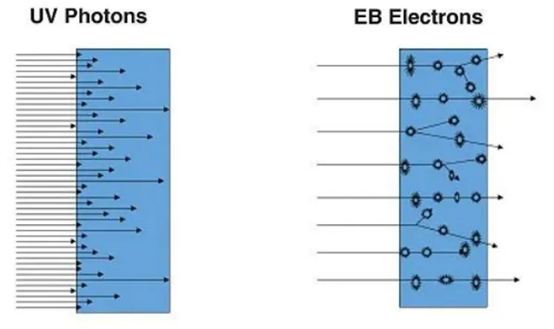
UV curing technology also performs well in production efficiency. Its curing speed is extremely fast, usually only 0.1-10 seconds to complete the curing process. In contrast, thermal drying technology usually takes several minutes or even longer to achieve the same curing effect. This huge difference in time directly affects production efficiency, making UV curing technology particularly suitable for high-speed production lines and mass production.
UV-cured coatings usually have a higher crosslinking density , which directly leads to better mechanical properties and chemical resistance. For example, UV-cured coatings usually show higher hardness, better impact resistance and excellent chemical resistance. These characteristics make UV curing technology particularly suitable for applications that require long-term outdoor use, such as building exterior wall coatings or protective coatings for automotive parts.
Overall, proper curing of UV-curable resins depends on several factors, including the type of resin used, the application method, the UV light source, and the environmental conditions during the curing process. Following the manufacturer's instructions and performing appropriate testing can help ensure that the resin has been properly cured and achieves the expected properties.
The origin of double solidification
Since the curing process of the UV light-curing system is triggered by light, the UV light-curing system also has the following disadvantages: limited curing depth; difficult to apply in colored systems and opaque materials; and the shape of the cured object cannot be too complex.
For this reason, a dual UV curing system combining light curing with other curing methods has been developed. In this system, the crosslinking or polymerization reaction of the system is completed through two independent stages with different reaction principles.
Ultraviolet light is used to quickly fix the system or achieve "surface drying", while dark reaction is used to fully cure the "shadow" part or inner layer to achieve "solid drying".
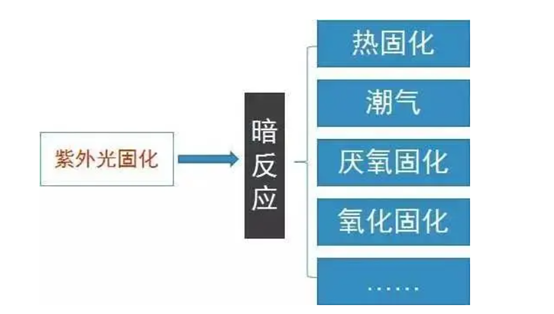
In fact, with the development of technology, the UVLED light source curing machine that is being promoted now can, to a certain extent, complete the above-mentioned dual light curing machine technology on one machine. The UV light source curing machine launched by Lanpu Li is such a machine. Its ultraviolet light reaction enables the UV ink to be fully cured.
Dual UV curing expands the application of UV curing adhesives in opaque media, complex-shaped substrates, ultra-thick adhesive layers and colored adhesive layers. This system gives UV curing adhesives greater competitiveness.
1. Relative to UV curing
Dual curing technology is a curing technology that combines UV curing with other curing methods. UV curing has its own disadvantages: it can only cure where UV light can reach, and it is difficult to completely cure where UV light cannot reach.
The dual curing method combines the advantages of various polymerization reactions and exhibits a good synergistic effect. It is a new method for modifying polymer materials and can expand the application of UV curing systems between opaque materials, on substrates with complex shapes, in ultra-thick coatings and colored coatings.
2. Relative to thermal curing
The resin can be pre-gelled by light irradiation, thus preventing the initial viscosity reduction during heat curing and eliminating the need for jigs. It can be fully cured by first fixing it with light and then heating it.
In addition, this dual-cure epoxy resin has a lower acrylate monomer content than conventional acrylate-type photocurable resins, and exhibits sufficient photocurability by adding a small amount of free radical photoinitiator, thereby obtaining a highly reliable cured product with less volatile gas during curing.
3. Synthesis of photothermal dual curing prepolymer
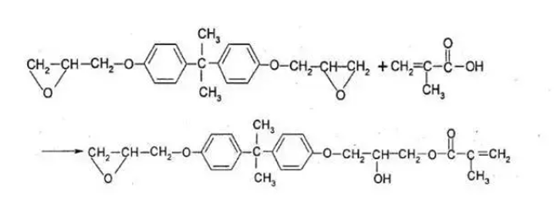
Using epoxy resin and methacrylic acid as raw materials, a methacrylate epoxy monoester that can be both UV-cured and thermally cured is synthesized. Its structure contains acrylic acid C=C double bonds and epoxy structure, which can overcome the incompatibility of system components and avoid local uneven curing.
4. Experimental flow chart of dual curing

5. Dual Curing - Moisture Curing
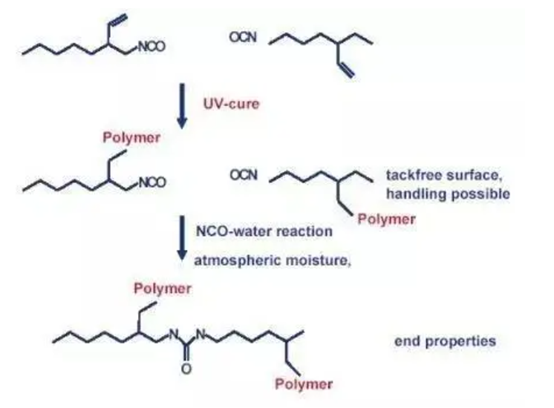
6. UV+heat dual curing
In modern industrial production, the curing technology of coatings and adhesives is a key link in determining product performance, production efficiency and environmental protection level. The traditional single curing method, whether relying on ultraviolet (UV) light or high temperature baking, has certain limitations.
In recent years, industry leaders have increased their investment in the research and development of dual curing technology (UV-heat dual system) and attracted the attention of the industry.
" dual curing technology " (UV-heat dual system) that combines the advantages of UV curing and thermal curing is gradually becoming the focus of the industry and is regarded as an important innovation direction in the coatings industry. It not only indicates that this technology has huge market potential, but also reflects the two giants' accurate grasp of future technological trends.
Meilun New Materials will conduct in-depth research and continue to make efforts in this field.
Dual curing technology refers to the simultaneous introduction of two different curing mechanisms into the same coating system, usually UV light curing and thermal curing , to achieve step-by-step or simultaneous curing of the coating.
The basic principle is: after coating, UV radiation is used to quickly dry the coating surface, and then heating is used to induce a thermal curing reaction, so that the coating is completely cross-linked and cured. This "two-pronged" curing method combines the advantages of two curing mechanisms and significantly improves coating performance and process efficiency.
UV curing has the characteristics of instant curing , which can dry and shape the coating surface within seconds. This means that the workpiece can quickly enter the next process after coating, greatly shortening the production cycle. The subsequent thermal curing ensures that the coating is fully cross-linked to achieve the final performance. Compared with traditional single thermal curing, which takes tens of minutes or even longer to bake, dual curing greatly improves production efficiency.
The coating formed by dual curing usually has both high hardness and flexibility. UV curing gives the coating a high cross-linking density , making its surface hard, scratch-resistant and chemical-resistant; while the thermal curing reaction further improves the cross-linking network, improves the adhesion and durability of the coating , and reduces internal stress and cracking risks. Studies have shown that the hardness, weather resistance and impact resistance of dual-curing coatings are often better than those of single-curing systems.
Solve the problem of curing in shadow areas
UV curing relies on light exposure, and it is often difficult to fully cure the shadowed areas (such as grooves and backs) of complex workpieces.
In the dual-curing system, thermal curing plays a "supplementary" role. Even in areas where UV light cannot directly reach, the coating can still be cured by heating.
This feature is particularly important for complex-shaped products such as automotive parts and electronic components, ensuring that the entire film is fully cured and avoiding performance defects caused by partial uncured film.
Dual curing technology allows the coating process to be flexibly switched or combined between UV and thermal curing. For example, UV pre-curing can be used to dry the coating surface for subsequent processing (such as molding and cutting), and then thermal curing can be used to finalize the shape.
This process sequence of “UV first, then heat” allows the coating to reach a non-sticky and transportable state in the middle stage, making subsequent operations easier.
At the same time, dual-curing coatings are compatible with the transformation of existing coating lines - just add a UV lamp after the original heat curing oven, or add a heating unit after the UV curing equipment to achieve the dual curing process. This reduces the threshold for enterprises to introduce new technologies.
UV curing usually adopts solvent-free or high solids formulation, which can significantly reduce volatile organic compound (VOC) emissions. Dual curing system inherits this environmental advantage, and because UV pre-curing reduces the time and temperature required for thermal curing, the overall energy consumption is expected to be reduced.
Dual curing reduces the curing temperature and shortens the curing time , thus saving energy. In addition, fast curing reduces the retention of workpieces in the oven, helping to reduce energy consumption and carbon emissions per unit product.
demonstrates significant advantages in both performance and efficiency through the synergistic effect of “1+1>2” and is regarded as an important upgrade direction for traditional single-cure technology.

environmental regulations become increasingly stringent, the market demand for high-performance, low-VOC coating technology is strong.
Curing technology fits this trend perfectly: on the one hand, it can provide high hardness and scratch resistance that are difficult to achieve with traditional thermal curing coatings, meeting the stringent requirements of coating durability in the automotive and electronics industries ; on the other hand, it greatly reduces the use of solvents through UV curing, conforming to the development direction of green coatings . Taking the automotive industry as an example, the coating of interior parts needs to take into account wear resistance, stain resistance and touch, while the vehicle manufacturers require the reduction of coating VOC emissions and energy consumption.
Dual-cure coatings are an ideal choice for automotive interior painting due to their excellent scratch and chemical resistance due to high cross-linking density and low energy consumption due to fast curing .
Similarly, in the fields of 3C electronics, aerospace, etc., the demand for high hardness, high adhesion and rapid curing of coatings has also promoted the application of dual curing technology.
In addition, the growth of emerging markets has also brought new demands. As one of the world's largest coatings consumer markets, the rapid development of the Asia-Pacific region provides broad space for dual-curing technology.
The manufacturing upgrades and infrastructure construction in China, India and other countries have led to an increasing demand for high-performance coatings. By increasing the research and development of dual-curing technology and launching products that meet local needs, we will consolidate and expand our market share.
From the perspective of technology development trends, dual-curing technology represents one of the directions for innovation and upgrading in the coatings industry . Traditional solvent-based thermal curing coatings are gradually showing limitations in terms of performance and environmental protection, while new technologies such as UV curing have advantages but also have shortcomings (such as shadow curing problems).
Dual curing makes up for the shortcomings of a single technology by integrating multiple curing mechanisms and is considered an important innovation in coating curing technology.
At the same time, dual curing technology is in line with the general trend of sustainable development . Governments around the world are increasingly stringent in restricting VOC and carbon emissions from coatings , pushing the industry to transform towards low VOC and low energy consumption.
Dual-cure coatings have extremely low VOC emissions due to the use of solvent-free or high-solid formulations, which complies with environmental regulations. In addition, their fast curing characteristics can reduce energy consumption and carbon emissions, helping companies achieve carbon neutrality goals.
Dual curing technology is considered as one of the "selling points" of future coatings . Mastering this technology will help companies establish barriers in the high-end market. Dual curing and other new technologies are used as a means of differentiated competition . Adding dual curing technology is also in line with the company's strategy of combining globalization and localization .
As environmental regulations become increasingly stringent and market demand for high-performance coatings grows, dual-cure, as a solution that "has its cake and eat it too" , will gain greater momentum. Driven by industries such as automobiles, electronics, and aviation, the market share of dual-cure coatings will gradually expand.
According to market research institutions, the global UV-curing coatings market will maintain steady growth, with an annual compound growth rate of more than 3%; and dual curing, as the upgrade direction of UV curing technology, is expected to grow faster than the overall UV coatings market.
At the same time, dual-curing technology itself is also constantly evolving. Future development directions may include: developing new dual-curing resins (such as resins containing both UV polymerizable groups and thermal curing groups), introducing smart curing concepts (such as photothermal synergistic initiation, self-healing coatings), and exploring multiple curing systems (such as UV-heat-moisture triple curing). These innovations will further improve coating performance and expand application boundaries.
For enterprises, increasing investment in the research and development of dual-curing technology is not only in line with the trend, but also an important measure to build a technological moat .
Seven: Application areas of dual curing
1、Automobile original paint, plastic coating; 2. General industrial coating; 3. Automobile repair paint; 4. Wood paint; 5. Building materials.
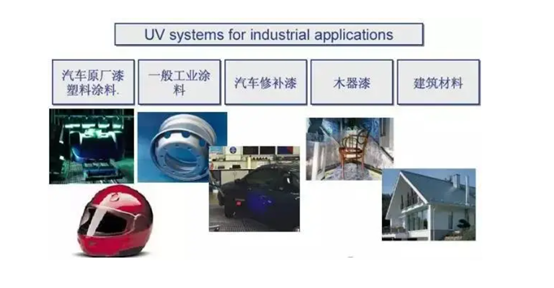
8. Application Examples of Dual Curing
For bonding between opaque materials, the UV curing adhesive can be applied first and then exposed to light before assembly. After assembly, the adhesive can undergo a dark reaction and cure reaction in the absence of light to achieve complete curing.
In addition, the life span of free radicals is short, and the reaction stops once there is no light. Moreover, the polymerization reaction rate initiated by free radicals is generally fast. Therefore, it is necessary to improve the free radical curing system and use a mixed initiator so that the system can decompose free radicals not only when exposed to light, but also when heated. On the other hand, volatile inhibitors can be added to the system to suppress the reaction rate when exposed to light.
9. The development prospects of dual curing
Applying dual curing technology to UV adhesives , protective coatings, sealing, high-speed installation and other fields will surely give UV materials stronger competitiveness.
dual-curing materials can overcome many limitations and expand the application of materials in opaque media, complex-shaped substrates, ultra-thick adhesive layers and colored adhesive layers. It provides conditions for light-curing bonding between opaque materials or bonding objects with complex shapes.




